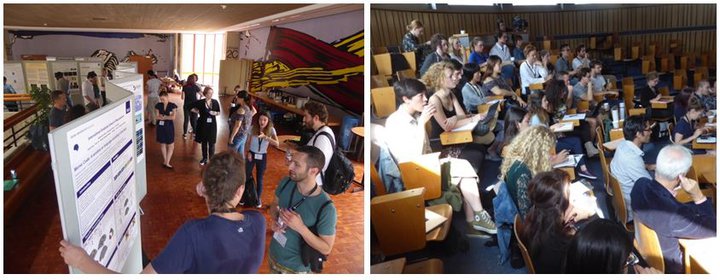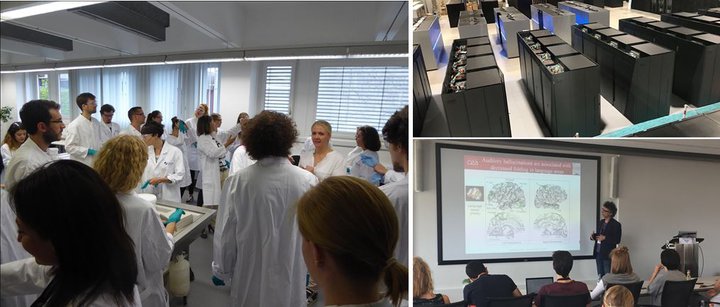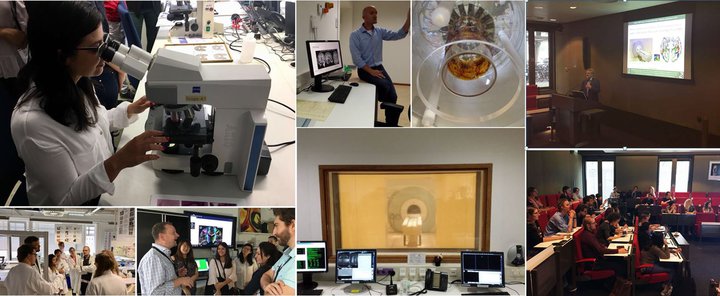HBP School - The HBP Human Brain Atlas: Neuroscientific basis, tools and applications
21 September 2018
Press Release 21 September 2018
From 3-7 September 2018, this season’s first HBP School took place in three different locations in Germany and the Netherlands. The programme gave an introduction into the HBP’s Human Brain Atlas. It provided insights into neuroanatomy and cognitive function of the human brain and an overview of selected methodologies used in the HBP to investigate its structural and functional organisation. 33 participants from various backgrounds got together to hear lectures by distinguished experts from within and outside HBP, take part in lab visits and dissection courses, and get on-site introductions to supercomputers and ultra-high field MRI scanners. It was jointly organised by HBP Scientific Director Katrin Amunts, who served as Scientific Chair of the School, Sabine Bradler from Forschungszentrum Jülich, and the HBP Education Programme Office in collaboration with the partners in Maastricht, Düsseldorf and Jülich.
The first two days took place at Heinrich Heine University Düsseldorf, where attendees were welcomed by Scientific Chair of the school Katrin Amunts.
Svenja Caspers (Forschungszentrum Jülich/ Heinrich Heine University Düsseldorf) guided through the first day by starting with an introduction to neuroanatomy and functional systems, followed by inviting the young scientists to a hands-on dissection course. In the afternoon, students learned more about cytoarchitectonic mapping and the JuBrain Atlas from Caspers and about neurotransmitter systems from Nicola Palomero-Gallagher (Forschungszentrum Jülich).
The morning of day 2 was dedicated to ethics in neurosciences, presented by Dieter Sturma and Bert Heinrichs (Jülich/University of Bonn). During the lunch break, participants had the chance to present their own research to their peers and the senior scientists in a poster session, resulting in lots of fruitful discussions. For the last point on the agenda, Claudia Häfner and Ursula Stangel (Jülich) provided useful information about Horizon 2020 and its political background, EU research funding opportunities and how to set thematic priorities.

On Wednesday, the HBP School participants learned about brain connectivity and were introduced to the HBP High Performance Analytics and Computing Platform. The program included talks on fibre architecture of the human brain and 3D Polarized Light Imaging by Markus Axer (Jülich), the variability of the cortical folding pattern and mapping of U-fibre bundles by Jean-François Mangin (CEA), diffusion-weighted MRI and aging by Svenja Caspers, and functional MRI and connectivity modelling by Simon Eickhoff (Jülich/HHU). Further items on the agenda were a lab visit where the young scientists learned more about brain slicing, light and high throughput microscopy and polarized light imaging, as well as a visit to the Jülich Supercomputers. The HBP School participants were among the first to see the brand-new JUWELS supercomputer!

Day 4 took the young researchers to Maastricht University. There, Rainer Goebel and Alard Roebroeck explained to them the potential and the possibilities that ultra-high field imaging offers for human brain imaging. Mario Senden introduced them to HBP’s Co-Design Project 4, which seeks to implement observations from cognitive neuroscience in robotic applications. In the afternoon, the HBP School attendants were invited to see the ultra-high (7 & 9.4 Tesla) magnetic fields MRI scanners at the Maastricht Brain Imaging Center. The program was concluded by Wim Vanduffel (KU Leuven), who explained the efforts made in the Human Brain Project to bridge the gaps between mice and human brain research.

On the last day of the HBP School on the Human Brain Atlas, participants returned to Forschungszentrum Jülich to learn more about the Human Brain Project Atlas, its role as part of the HBP Neuroinformatics Platform, and big data analytics for cellular-level brain mapping from Timo Dickscheid, Co-leader of the HBP Neuroinformatics Platform. The program also included a hands-on session on browsing reference atlases online, guided by Sebastian Bludau, as well as tutorials on bringing data to the HBP Atlas (tutors: Lyuba Zehl, Sara Zafarnia, Stefan Köhnen, Yann Leprince) and using the Neuroinformatics Platform for analysis (tutors: Timo Dickscheid, Anna Kreshuk).

Further information about the HBP Education Programme activities and upcoming events: https://humanbrainproject.eu/education
Contact: education@humanbrainproject.eu

HBP Open Day 2018 on October 15
Do you also want to meet our researchers and learn how Europe's biggest brain science project works? Then join us for the HBP Open Day 2018 at MEEC Maastricht on October 15! The Open Day presents latest developments on how modern computing technologies enhance our understanding of the human brain, how this knowledge can be applied to develop new diagnostic and therapeutic tools for brain disorders, and how it can inspire new technologies. At a dedicated HBP Science Market, visitors can learn about HBP from different virtual and physical exhibits, such as exploring the brain in virtual and augmented reality or interacting with smart robots. It is free to attend and open to the public.
Registrations are open now - find more information at:
https://www.hbpopendaysummit-2018.org/openday/programme
Or download the event flyer.



